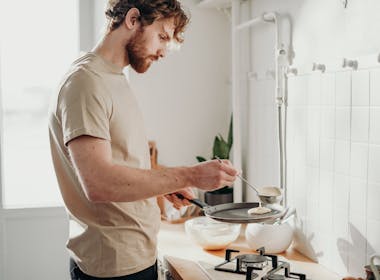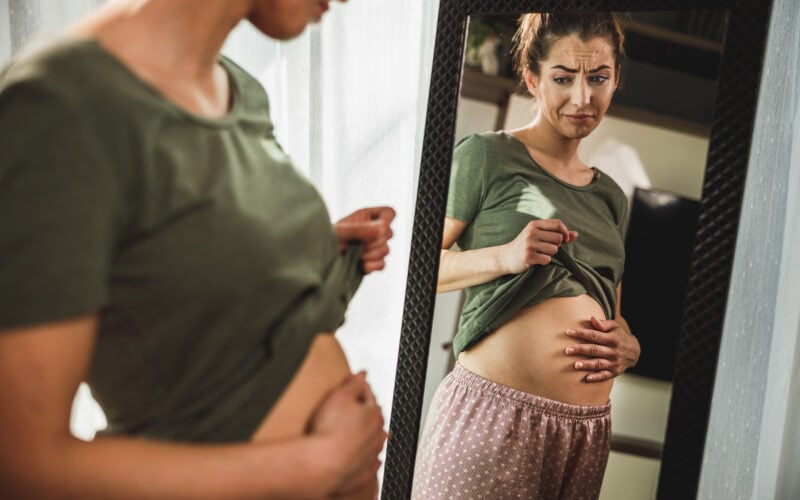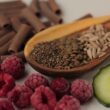From the very first time I experienced endo belly, I knew without a doubt that something was wrong. I had experienced bloating before, but this…this was different. It was more than a puffiness that made my jeans feel tight. My belly was so swollen and distended that I felt like I would burst. My skin and insides felt like they were ripping apart when I would breathe or stand up. It was painful, I looked six months pregnant, and it was hard to eat and drink.
When I mentioned it to my doctors, they all suspected IBS. Yet, I knew that what I was experiencing was different. As a nurse, I’d heard hundreds of patients describe how IBS felt, and none of those descriptors matched mine. The only times I had heard patients describe similar symptoms were with internal bleeding or ascites (i.e., abdominal swelling caused by a buildup of fluid, and often associated with liver disease). Interestingly, what happens with endo belly isn’t that dissimilar!
What is endo belly?
Endo belly is a colloquial term used by endometriosis sufferers to refer to the painful abdominal bloating and swelling specific to endometriosis. It is usually accompanied by nausea, loss of appetite, diarrhea or constipation, gas pain, and pressure in the abdomen and lower back. Endo belly can last for hours, days, or weeks. The bloating can happen at any time during the menstrual cycle, though it tends to worsen leading up to the period.
How common is it? According to one study, “a significantly larger proportion of women with endometriosis than control subjects experienced abdominal bloating (96% vs. 64%)” [1]. Of the 25 women with endometriosis studied, 30% experienced severe discomfort along with abdominal bloating. Another study of 290 women diagnosed with endometriosis found that 90% experienced GI symptoms, with bloating being the most common [2].
Why does it happen? Chronic widespread inflammation due to the presence of endometriosis lesions stimulates an immune response that leads to pain, inflammation, and swelling [3]. According to the Mayo Clinic, “the endometrial-like tissue acts as endometrial tissue would — it thickens, breaks down and bleeds with each menstrual cycle. But because this tissue has no way to exit your body, it becomes trapped.” The result is pain, scar tissue, adhesions, and swelling.
There is some evidence that those who suffer from endometriosis may also have altered gut microbiota, which may be an explanation behind some of the adverse intestinal symptoms associated with the disease. However, more research on this connection is needed. Other potential causes of the intestinal discomfort experienced by endo sufferers could be: ovarian cysts, medication use (like opioids or GnRH analogs), and dietary intolerances/sensitivities.
Five tips for managing an endo belly flare
As devastating and debilitating as endo belly may be, the good news is that there are ways to manage it! Though preventing endo belly is a priority, feeling better in the moment is also important. Here are five tips to help you feel better when endo belly hits:
1. Wear loose clothes
While you may be naturally inclined to choose loose clothes when you’re bloated, it is important to avoid tight clothes. Restrictive clothing actually makes the bloating and pain worse.
Choose items with a loose waistband, avoid high waisted pants, and avoid tops with cinches around the waist. You’ll feel better by giving the belly space to expand. Consider it like not adding any fuel to the fire. If you’re already feeling tightness and swelling, you don’t want to add external pressure.
My favorite thing to wear during an endo belly flare is a flowy dress. Of course, the weather limits the days I can reasonably dress this way. When it’s colder, I prefer to wear stretchy leggings and a loose sweater or t-shirt.
2. Drink herbal tea
Some endo belly sufferers may find relief in drinking teas made from particular herbs, especially peppermint, ginger, and chamomile, all of which have been used to treat various ailments since ancient times!
According to Healthline, there is evidence that compounds found in peppermint, in particular, could be helpful in reducing bloating and soothing the digestive system. In human studies, ginger has been shown to successfully relieve nausea for some people. And while human studies are needed to confirm its effects on gut health, compounds found in chamomile flowers may be beneficial for a variety of stomach and intestinal discomforts. Since endo belly is often accompanied by nausea and feelings of pressure, teas made from these herbs may be helpful for relieving symptoms.
Some believe that drinking hot or warm liquids can soothe the digestive tract and relax muscles. But if the idea of sipping a cup of hot tea can be daunting when you feel stuffed to the brim, try it lukewarm. You may still get some stomach-soothing benefits from the herbs.
3. Eat easily digestible foods
Just like we don’t want to add fuel to the fire externally with tight clothing, we don’t want to do it internally. Raw fruits and vegetables, while healthy and nutritious, can cause a build up of gas. Cooking these foods before consuming may make this less likely!
As with hot teas, some theorize that warm foods are also soothing to the digestive tract and make digestion easier, resulting in less discomfort and gas. Similarly, foods like smoothies and soups may be more digestible and therefore more gentle on the stomach.
Avoid any food that makes you feel sick or just not your best! For example, coffee tends to make my cramps and bloating worse. As much as it makes me feel good mentally, I don’t drink coffee during an endo belly flare because I don’t want to add to the bloating I’m already experiencing.
4. Move gently
As with most ailments, getting in some movement may do wonders for your endo belly. Gentle yoga or other stretching practices will allow your body to twist, which may stimulate digestion and could help relieve gas.
Walking helps get the intestines moving, which relieves gas and bloating, as well as reduces stress. According to one study, “the greatest payoff, in terms of efficiently lowering levels of the stress hormone cortisol” comes from “20 to 30 minutes sitting or walking in a place that provides you with a sense of nature” [4]. Stress hormones contribute to inflammation, which may worsen inflammation in people with endo belly.
Avoid high intensity workouts during an endo belly flare. Likely you won’t even consider it because you’ll be so uncomfortable! You should know, however, that there is evidence that high-intensity workouts can cause a spike in cortisol levels. If you are already dealing with high cortisol levels (due to endometriosis), adding more may not help, especially if you’re not taking the time to rest during particular parts of your cycle (like your period!).
5. Apply heat
Heat reduces pain by increasing blood flow to the area where it’s applied, relaxing muscles, and relieving tension. Try applying a heat pad to your lower abdomen to relieve pain and cramping. In this interview for the Endometriosis Foundation of America, Dr. Sophie Chung states that, “Heat over 104 degrees Fahrenheit (40 Celsius) stimulates your sensory receptors, which block the transmission of pain signals to the brain, resulting in an instant and effective pain relief.”
You may also try taking a hot bath! For more benefits, I like to add epsom salts, which are high in magnesium, which could further reduce bloating. If you are going to apply heat or take a bath, limit it to just 20-30 minutes, as benefits plateau and the risk of injury increases after that.
Finding hope as you build your Endo toolbox
Endo belly is one of the most devastating symptoms of endometriosis. It seems to come out of nowhere and stays as long as it likes. As terrible as it is to experience, the good news is that there are ways to manage it. It just takes some trial and error to find what works best for you. Adding tips like these to your endo toolbox will prepare you for an endo belly flare.
References:
[1] Luscombe G, Markham R, Judio M, Grigoriu A, Fraser I. “Abdominal bloating: an under-recognized endometriosis symptom.” Journal of Obstetrics and Gynaecology Canada, vol. 31, no. 12 (2009): pp. 1159-71. doi:10.1016/S1701-2163(16)34377-8 [2] Maroun P, Cooper MJW, Reid G, Keirse MJNC. “Relevance of gastrointestinal symptoms in endometriosis.” Australian and New Zealand Journal of Obstetrics and Gynaecology, vol. 49, no. 4 (2009): pp. 411-14. doi:10.1111/j.1479-828x.2009.01030.x [3] Machairiotis N, Vasilakaki S, Thomakos N. “Inflammatory mediators and pain in endometriosis: a systematic review.” Biomedicines, vol. 9, no. 1 (2021): p. 54. doi:10.3390/biomedicines9010054 [4] Hunter M, Gillespie B, Chen S. “Urban nature experiences reduce stress in the context of daily life based on salivary biomarkers.” Frontiers in Psychology, vol. 10 (2019). https://doi.org/10.3389/fpsyg.2019.00722Additional Reading:
5 lesser known symptoms of endometriosis you might not know about
“What causes endometriosis?” and other questions: a Natural Womanhood Endo FAQ
How to get an endometriosis diagnosis and find truly restorative treatment
How I got help with endometriosis without the Pill
Can acupuncture relieve your endometriosis-related period pain?







